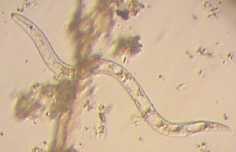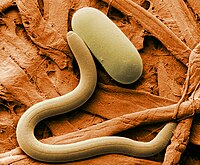Nematodes
| Nemotodes | |
|---|---|
 |
he nematodes or roundworms (Phylum Nematoda from Greek νῆμα (nema): "thread" + -ώδη (-ode) "like") are one of the most common phyla of animals, with over 20,000 different described species (over 15,000 are parasitic). They are ubiquitous in freshwater, marine, and terrestrial environments, where they often outnumber other animals in both individual and species counts, and are found in locations as diverse as Antarctica and oceanic trenches. Further, there are a great many parasitic forms, including pathogens in most plants and animals, humans included. Only the Arthropoda are more diverse.
Abundance
[edit | edit source]Nematodes have successfully adapted to nearly every ecological niche from marine to fresh water, from the polar regions to the tropics, as well as the highest to the lowest of elevations. Though 20,000 species have been classified it is estimated that this number may be upwards of 500,000 if all were known.[1]. In certain fertile areas the topsoil is estimated to contain in the billions of nematodes per acre.[2] In the 1914 edition of the Yearbook of the United States Department of Agriculture N.A.Cobb wrote on the abundance of nematodes[2]: "If all the matter in the universe except the nematodes were swept away, our world would still be dimly recognizable, and if, as disembodied spirits, we could then investigate it, we should find its mountains, hills, vales, rivers, lakes and oceans represented by a thin film of nematodes. The location of towns would be decipherable, since for every massing of human beings there would be a corresponding massing of certain nematodes. Trees would still stand in ghostly rows representing our streets and highways. The location of the various plants and animals would still be decipherable, and, had we sufficient knowledge, in many cases even their species could be determined by an examination of their erstwhile nematode parasites."
Morphology
[edit | edit source]Nematodes are unsegmented, thin and are round in cross section. They have no circulatory or respiratory systems so they use diffusion to breathe and for circulation of substances around their body. Nematodes are one of the simplest animal groups to have a complete digestive system, with a separate orifice for food intake and waste excretion, a pattern followed by all subsequent, more complex animals. The body cavity lacks the muscles of coelomate animals used to force food down the digestive tract. Nematodes thus depend on internal/external pressures and body movement to move food through their digestive tracts. The mouth is often surrounded by various flaps or projections used in feeding and sensation. The portion of the body past the anus is called the "tail." As they grow, their cells get larger, but the total number is constant. The epidermis secretes a layered cuticle made of three layers of collagen[2] that protects the body from drying out, or from digestive juices or other damaging substances. Although this cuticle allows movement and shape changes, it is very inelastic so does not allow the volume of the worm to increase. Therefore, as the worm grows, it has to molt and form new cuticles. The cuticles don't allow volume to increase so as to keep hydrostatic pressure inside the organism very high. For this reason, the roundworms do not possess circular muscles (just longitudinal ones) as they're not required. This hydrostatic pressure is the reason the roundworms are round.
Most free-living nematodes are microscopic, though a few parasitic forms can grow to over a meter in length (typically as parasites of very large animals such as whales).
Most nematodes eat bacteria, fungi and protozoans, although some are filter feeders. Excretion is through a separate excretory pore.
Nematodes have a simple nervous system, with a main nerve cord running along the ventral side.
Free-living species
[edit | edit source]In free-living species, development usually consists of four molts of the cuticle during growth. Different species feed on materials as varied as algae, fungi, small animals, fecal matter, dead organisms and living tissues. One roundworm of note is Caenorhabditis elegans, which lives in the soil and has found much use as a model organism. C. elegans has had its entire genome sequenced, as well as the developmental fate of every cell determined, and every neuron mapped.
Parasitic species
[edit | edit source]Nematodes that are parasitic on animals often have quite complicated life cycles, moving between several different hosts or locations in the host's body. Infection occurs variously by eating uncooked meat with larvae in it, by entrance into unprotected cuts or directly through the skin, by transfer via blood-sucking insects, etc.
In contrast, entomopathogenic nematodes parasitize insects and are considered by humans to be beneficial.
One form of nematode is entirely dependent upon the wasps which are the sole source of fig fertilization. They prey upon the wasps, riding them from the ripe fig of the wasp's birth to the fig flower of its death, where they kill the wasp, and their offspring await the birth of the next generation of wasps as the fig ripens.
Plant parasitic nematodes include several groups causing severe crop losses. The most common genera are: Aphelenchoides (foliar nematodes), Meloidogyne (root-knot nematodes), Heterodera, Globodera (cyst nematodes) such as the potato root nematode, Nacobbus, Pratylenchus (lesion nematodes), Ditylenchus, Xiphinema, Longidorus, Trichodorus. Several phytoparasitic nematode species cause histological damages to roots, including the formation of visible galls (Meloidogyne) which are useful characters for their diagnostic in the field. Some nematode species transmit plant viruses through their feeding activity on roots. One of them is Xiphinema index, vector of GFLV (Grapevine Fanleaf Virus), an important disease of grapes.
Other nematodes attack bark and forest trees. The most important representative of this group is Bursaphelenchus xylophilus, the pine wood nematode, present in Asia and America and recently discovered in Europe.
The largest known nematode is Dioctophyma renale, the giant kidney worm, a parasite most commonly found in mink but also in dogs and humans, that can reach up to 103 cm in length.[3]
Gardening
[edit | edit source]
Depending on the species, a nematode may be beneficial or detrimental to a gardener's cause.
From a gardening perspective, there are two categories of nematode: predatory ones, which will kill garden pests like cutworms or Japanese beetle grubs, and pest nematodes, like the root-knot nematode, which attack garden plants.
Predatory nematodes can be bred by soaking a specific recipe of leaves and other detritus in water, in a dark, cool place, and can even be purchased as an organic form of pest control.
References
[edit | edit source]- ↑ Hyman, L.H. The invertebrates, vol. III. Acanthocephala, Aschelminthes, and Entoprocta, the pseudocoelomate Bilateria. New York: Mc Graw Hill. ISBN 0070316619.
- ↑ a b c Hickman, Cleveland. Animal Diversity (4th ed.). New York: Mc Graw Hill. ISBN 978-0-07-252844-2.
{{cite book}}: Unknown parameter|coauthors=ignored (|author=suggested) (help) - ↑ "Giant Kidney Worm Infection in Mink and Dogs". The Merck Veterinary Manual. 2006. Retrieved 2007-02-10.
External links
[edit | edit source]- http://www.ucmp.berkeley.edu/phyla/ecdysozoa/nematoda.html
- Nematode.net: Repository of parasitic nematode sequences.
- http://www.nematodes.org/
- NeMys World free-living Marine Nematodes database
- Nematode Virtual Library
- International Federation of Nematology Societies
- Society of Nematologists
- Australasian Association of Nematologists
